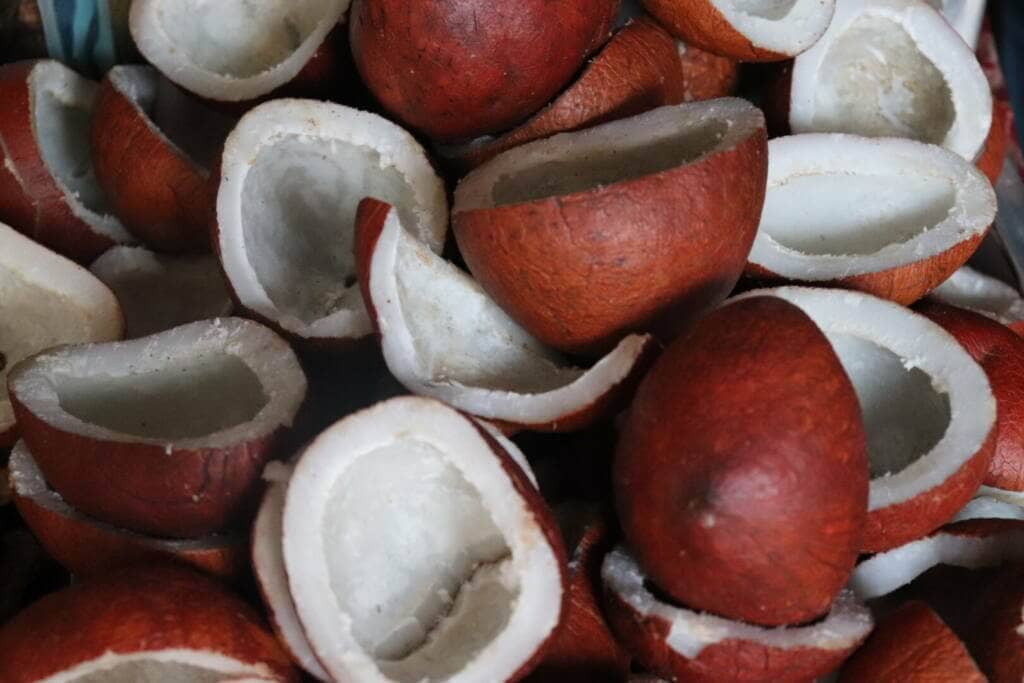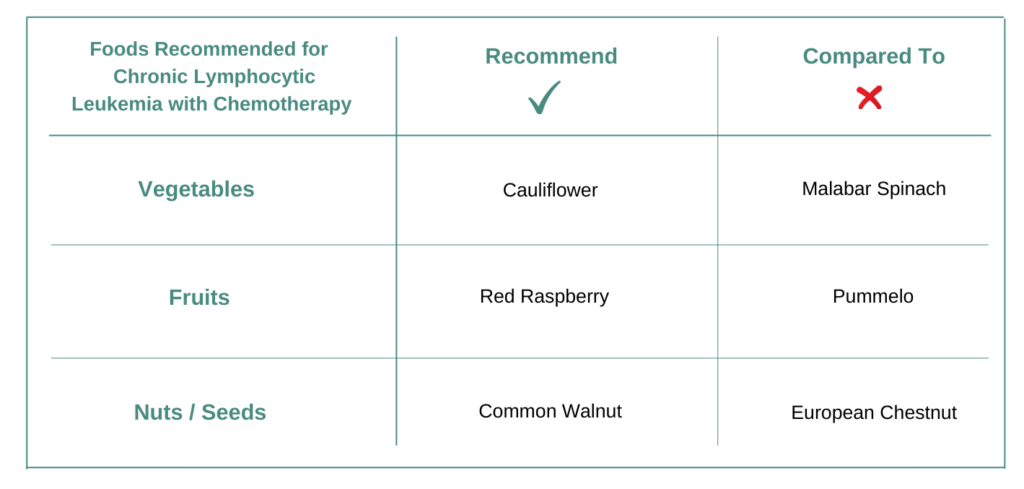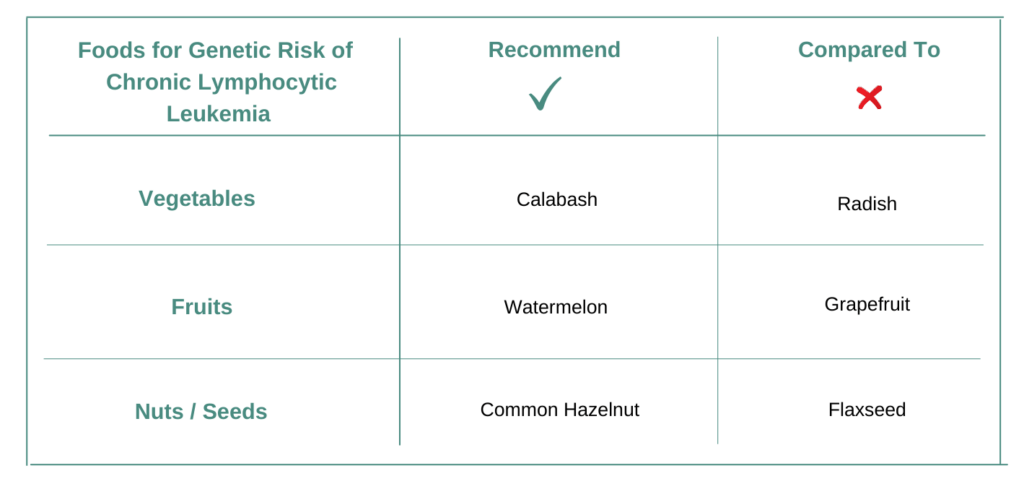Introduction
Foods for Chronic Lymphocytic Leukemia should be personalized for each individual and also must adapt when cancer treatment or tumor genetic change. The personalization and adaptation must consider all the active ingredients or bioactives contained in different foods with respect to cancer tissue biology, genetics, treatments, lifestyle conditions and diet preferences. Hence while nutrition is one of the very important decisions for a cancer patient and individual at risk of cancer to make – how to choose foods to eat is not an easy task.
Chronic lymphocytic leukemia (CLL) is a cancer of the blood and bone marrow, that has a slow rate of progression when compared to the acute forms of leukemia. Lymphocytic leukemia affects the lymphocytes or white blood cells, that help the body fight infection. Primary disease sites include peripheral blood, spleen, lymph node and bone marrow. CLL mostly affects older adults with an average age of 70 years. Incidence of CLL is higher in western population, with higher incidence in Caucasian compared to Asian and African American population. Initially patients with CLL do not have any symptoms, but the symptoms develop as the cancer progresses. Signs and symptoms of CLL include enlarged but painless lymph nodes, fatigue, fever, enlarged spleen that may cause pain in the abdomen, night sweats, weight loss and frequent infections. In CLL, the abnormal non-functional lymphocytes start accumulating in the blood and certain organs over time and cause complications. These abnormal lymphocytes crowd out the healthy cells in the bone marrow and interfere with production of blood cells. Patients with CLL are not treated with chemotherapy until they become symptomatic. Targeted agents that inhibit specific driver pathways are the preferred first line therapy for CLL and therapy selection for CLL takes into account the molecular and genetic characteristics of the disease and may include a combination of targeted agents and chemotherapy. CLL being a slowly progressing disease has a relatively good prognosis with most patients living 5-10 years. Supportive care with the right foods and natural supplements can help improve the quality of life of the patients.
For Chronic Lymphocytic Leukemia does it matter what vegetables, fruits, nuts, seeds one eats?
A very common nutrition question asked by cancer patients and individuals at-genetic risk of cancer is – for cancers like Chronic Lymphocytic Leukemia does it matter what foods I eat and which I do not? Or if I follow a plant-based diet is that enough for cancer like Chronic Lymphocytic Leukemia?
For example does it matter if vegetable Cauliflower is consumed more compared to Malabar Spinach? Does it make any difference if fruit Pummelo is preferred over Red Raspberry? Also if similar choices are made for nuts/seeds like Common Walnut over European Chestnut and for pulses like Black-eyed Pea over Yellow Wax Bean. And if what I eat matters – then how does one identify foods which are recommended for Chronic Lymphocytic Leukemia and is it the same answer for everyone with the same diagnosis or genetic risk?
Yes! Foods you eat matters for Chronic Lymphocytic Leukemia!
Food recommendations may not be the same for everyone and can be different even for the same diagnosis and genetic risk.

All foods (vegetables, fruits, nuts, seeds, pulses, oils etc.) and nutritional supplements are made up of more than one active molecular ingredient or bio-actives in different proportions and quantities. Each active ingredient has a unique mechanism of action – which can be activation or inhibition of different biochemical pathways. Simply stated foods and supplements which are recommended are those which do not cause an increase of molecular drivers of cancer but reduce them. Else those foods should not be recommended. Foods contain multiple active ingredients – hence when evaluating foods and supplements you need to consider the impact of all active ingredients cumulatively rather than individually.
For example Pummelo contains active ingredients Curcumin, Apigenin, Lycopene, Daidzein, Lupeol. And Red Raspberry contains active ingredients Curcumin, Ellagic Acid, Daidzein, Lupeol, Phloretin and possibly others.
A common mistake made when deciding and choosing foods to eat for Chronic Lymphocytic Leukemia – is to evaluate only selected active ingredients contained in foods and ignore the rest. Because different active ingredients contained in foods may have opposing effects on cancer drivers – you cannot cherry pick active ingredients in foods and supplements for making a nutrition decision for Chronic Lymphocytic Leukemia.
YES – FOOD CHOICES MATTER FOR CANCER. NUTRITION DECISIONS MUST CONSIDER ALL ACTIVE INGREDIENTS OF FOODS.
Skills Needed for Nutrition Personalization for Chronic Lymphocytic Leukemia?
Personalized nutrition for cancers like Chronic Lymphocytic Leukemia consists of recommended foods / supplements; not recommended foods / supplements with example recipes which prioritize use of recommended foods. An example of personalized nutrition can be seen at this link.
Deciding which foods are recommended or not is extremely complicated, requiring expertise in Chronic Lymphocytic Leukemia biology, food science, genetics, biochemistry along with good understanding of how cancer treatments work and associated vulnerabilities by which the treatments could stop being effective.
MINIMUM KNOWLEDGE EXPERTISE NEEDED FOR NUTRITION PERSONALIZATION FOR CANCER ARE: CANCER BIOLOGY, FOOD SCIENCE, CANCER TREATMENTS AND GENETICS.
Foods to Eat After Cancer Diagnosis!
No two cancers are the same. Go beyond the common nutrition guidelines for everyone and make personalized decisions about food and supplements with confidence.
Characteristics of cancers like Chronic Lymphocytic Leukemia
All cancers like Chronic Lymphocytic Leukemia can be characterized by a unique set of biochemical pathways – the signature pathways of Chronic Lymphocytic Leukemia. Biochemical pathways like DNA Repair, Apoptosis, NFKB Signaling, Phospholipase Signaling are part of the signature definition of Chronic Lymphocytic Leukemia. Each individual’s cancer genetics can be different and hence their specific cancer signature could be unique.
The treatments which are effective for Chronic Lymphocytic Leukemia need to be cognizant of the associated signature biochemical pathways for each cancer patient and individual at genetic risk. Therefore different treatments with different mechanisms of actions are effective for different patients. Similarly and for the same reasons foods and supplements need to be personalized for each individual. Hence some foods and supplements are recommended for Chronic Lymphocytic Leukemia when taking cancer treatment Fludarabine, and some foods and supplements are not recommended.
Sources like cBioPortal and many others provide population representative patient anonymized data from clinical trials for all cancer indications. This data consists of clinical trial study details like sample size / number of patients, age groups, gender, ethnicity, treatments, tumor site and any genetic mutations.
BTK, SF3B1, TP53, CHD2 and XPO1 are the top ranked reported genes for Chronic Lymphocytic Leukemia. BTK is reported in 12.0 % of the representative patients across all clinical trials. And SF3B1 is reported in 11.4 %. The combined population patient data cover ages from 40 to 84. 64.0 % of the patient data are identified as men. The Chronic Lymphocytic Leukemia biology along with reported genetics together define the population represented signature biochemical pathways for this cancer. If the individual cancer tumor genetics or genes contributing to the risk are also known then that should also be used for nutrition personalization.
NUTRITION CHOICES SHOULD MATCH WITH EACH INDIVIDUAL’S CANCER SIGNATURE.
Food and Supplements for Chronic Lymphocytic Leukemia
For Cancer Patients
Cancer patients on treatment or on palliative care need to make decisions on food and supplements – for the needed dietary calories, for managing any treatment side effects and also for improved cancer management. All plant-based foods are not equal and choosing and prioritizing foods which are personalized and customized to ongoing cancer treatment is important and complicated. Here are some examples providing guidelines for making nutrition decisions.
Choose Vegetable CAULIFLOWER or MALABAR SPINACH?
Vegetable Cauliflower contains many active ingredients or bioactives such as Curcumin, Daidzein, Lupeol, Phloretin, Psoralen. These active ingredients manipulate various biochemical pathways like Amino Acid Metabolism, Cell Cycle Checkpoints, PI3K-AKT-MTOR Signaling and Apoptosis and others. Cauliflower is recommended for Chronic Lymphocytic Leukemia when ongoing cancer treatment is Fludarabine. This is because Cauliflower modifies those biochemical pathways which have been scientifically reported to sensitize the effect of Fludarabine.
Some of the active ingredients or bioactives in vegetable Malabar Spinach are Curcumin, Apigenin, Lycopene, Myricetin, Daidzein. These active ingredients manipulate various biochemical pathways like DNA Repair and others. Malabar Spinach is not recommended for Chronic Lymphocytic Leukemia when ongoing cancer treatment is Fludarabine because it modifies those biochemical pathways which make the cancer treatment resistant or less responsive.
VEGETABLE CAULIFLOWER IS RECOMMENDED OVER MALABAR SPINACH FOR Chronic Lymphocytic Leukemia AND TREATMENT Fludarabine.
Choose Fruit RED RASPBERRY or PUMMELO?
Fruit Red Raspberry contains many active ingredients or bioactives such as Curcumin, Ellagic Acid, Daidzein, Lupeol, Phloretin. These active ingredients manipulate various biochemical pathways like Amino Acid Metabolism, Cell Cycle Checkpoints, PI3K-AKT-MTOR Signaling and Apoptosis and others. Red Raspberry is recommended for Chronic Lymphocytic Leukemia when ongoing cancer treatment is Fludarabine. This is because Red Raspberry modifies those biochemical pathways which have been scientifically reported to sensitize the effect of Fludarabine.
Some of the active ingredients or bioactives in fruit Pummelo are Curcumin, Apigenin, Lycopene, Daidzein, Lupeol. These active ingredients manipulate various biochemical pathways like DNA Repair and others. Pummelo is not recommended for Chronic Lymphocytic Leukemia when ongoing cancer treatment is Fludarabine because it modifies those biochemical pathways which make the cancer treatment resistant or less responsive.
FRUIT RED RASPBERRY IS RECOMMENDED OVER PUMMELO FOR Chronic Lymphocytic Leukemia AND TREATMENT Fludarabine.
Choose Nut COMMON WALNUT or EUROPEAN CHESTNUT?
Common Walnut contains many active ingredients or bioactives such as Curcumin, Ellagic Acid, Myricetin, Daidzein, Lupeol. These active ingredients manipulate various biochemical pathways like Nucleotide metabolism, Cell Cycle Checkpoints, PI3K-AKT-MTOR Signaling and T-Cell Receptor Signaling and others. Common Walnut is recommended for Chronic Lymphocytic Leukemia when ongoing cancer treatment is Fludarabine. This is because Common Walnut modifies those biochemical pathways which have been scientifically reported to sensitize the effect of Fludarabine.
Some of the active ingredients or bioactives in European Chestnut are Curcumin, Apigenin, Ellagic Acid, Myricetin, Daidzein. These active ingredients manipulate various biochemical pathways like DNA Repair and others. European Chestnut is not recommended for Chronic Lymphocytic Leukemia when ongoing cancer treatment is Fludarabine because it modifies those biochemical pathways which make the cancer treatment resistant or less responsive.
COMMON WALNUT IS RECOMMENDED OVER EUROPEAN CHESTNUT FOR Chronic Lymphocytic Leukemia AND TREATMENT Fludarabine.

For Individuals with Genetic Risk of Cancer
The question asked by individuals who have genetic risk of Chronic Lymphocytic Leukemia or familial history is “What Should I Eat Differently from Before?” and how they should choose foods and supplements to manage risks of the disease. Since for cancer risk there is nothing actionable in terms of treatment – decisions of foods and supplements become important and one of the very few actionable things which can be done. All plant-based foods are not equal and based on identified genetics and pathway signature – the choices of food and supplements should be personalized.
Choose Vegetable CALABASH or RADISH?
Vegetable Calabash contains many active ingredients or bioactives such as Apigenin, Curcumin, Formononetin, Lupeol, Daidzein. These active ingredients manipulate various biochemical pathways like Oxidative Stress, JAK-STAT Signaling, PI3K-AKT-MTOR Signaling and Oncogenic Cancer Epigenetics and others. Calabash is recommended for risk of Chronic Lymphocytic Leukemia when associated genetic risk is CHD2. This is because Calabash increases those biochemical pathways which counteract the signature drivers of it.
Some of the active ingredients or bioactives in vegetable Radish are Apigenin, Curcumin, Formononetin, Lupeol, Daidzein. These active ingredients manipulate various biochemical pathways like Oxidative Stress, PI3K-AKT-MTOR Signaling, DNA Repair and MYC Signaling and others. Radish is not recommended when risk of Chronic Lymphocytic Leukemia when associated genetic risk is CHD2 because it increases the signature pathways of it.
VEGETABLE CALABASH IS RECOMMENDED OVER RADISH FOR CHD2 GENETIC RISK OF CANCER.
Choose Fruit WATERMELON or GRAPEFRUIT?
Fruit Watermelon contains many active ingredients or bioactives such as Curcumin, Formononetin, Lupeol, Daidzein, Phloretin. These active ingredients manipulate various biochemical pathways like Oxidative Stress, JAK-STAT Signaling, PI3K-AKT-MTOR Signaling and Oncogenic Cancer Epigenetics and others. Watermelon is recommended for risk of Chronic Lymphocytic Leukemia when associated genetic risk is CHD2. This is because Watermelon increases those biochemical pathways which counteract the signature drivers of it.
Some of the active ingredients or bioactives in fruit Grapefruit are Curcumin, Formononetin, Lupeol, Daidzein, Naringin. These active ingredients manipulate various biochemical pathways like Oxidative Stress and others. Grapefruit is not recommended when risk of Chronic Lymphocytic Leukemia when associated genetic risk is CHD2 because it increases the signature pathways of it.
FRUIT WATERMELON IS RECOMMENDED OVER GRAPEFRUIT FOR CHD2 GENETIC RISK OF CANCER.
Choose Nut COMMON HAZELNUT or FLAXSEED?
Common Hazelnut contains many active ingredients or bioactives such as Curcumin, Formononetin, Lupeol, Daidzein, Phloretin. These active ingredients manipulate various biochemical pathways like Oxidative Stress, JAK-STAT Signaling, PI3K-AKT-MTOR Signaling and Oncogenic Cancer Epigenetics and others. Common Hazelnut is recommended for risk of Chronic Lymphocytic Leukemia when associated genetic risk is CHD2. This is because Common Hazelnut increases those biochemical pathways which counteract the signature drivers of it.
Some of the active ingredients or bioactives in Flaxseed are Apigenin, Curcumin, Formononetin, Lupeol, Daidzein. These active ingredients manipulate various biochemical pathways like Oxidative Stress, JAK-STAT Signaling and PI3K-AKT-MTOR Signaling and others. Flaxseed is not recommended when risk of Chronic Lymphocytic Leukemia when associated genetic risk is CHD2 because it increases the signature pathways of it.
COMMON HAZELNUT IS RECOMMENDED OVER FLAXSEED FOR CHD2 GENETIC RISK OF CANCER.

In Conclusion
Foods and Supplements chosen are important decisions for cancers like Chronic Lymphocytic Leukemia. Chronic Lymphocytic Leukemia patients and individuals with genetic-risk always have this question: “What foods and nutritional supplements are recommended for me and which are not?” There is a common belief which is a misconception that all plant-based foods could be beneficial or not but would not be harmful. Certain foods and supplements can interfere with cancer treatments or promote molecular pathway drivers of cancer.
There are different types of cancer indications like Chronic Lymphocytic Leukemia, each with different tumor genetics with further genomic variations across each individual. Further every cancer treatment and chemotherapy has a unique mechanism of action. Each food like Cauliflower contains various bioactives in different quantities, which have an impact on different and distinct sets of biochemical pathways. The definition of personalized nutrition is individualized food recommendations for the cancer indication, treatments, genetics, lifestyle and other factors. Nutrition personalization decisions for cancer require knowledge of cancer biology, food science and an understanding of different chemotherapy treatments. Finally when there are treatment changes or new genomics is identified – the nutrition personalization needs re-evaluation.
The addon nutrition personalization solution makes the decision making easy and removes all the guesswork in answering the question, “What foods should I choose or not choose for Chronic Lymphocytic Leukemia?”. The addon multi-disciplinary team includes cancer physicians, clinical scientists, software engineers and data scientists.
Personalized Nutrition for Cancer!
Cancer changes with time. Customize and modify your nutrition based on cancer indication, treatments, lifestyle, food preferences, allergies and other factors.
References
- Cll Iuopa 2015
- Pan-cancer analysis of whole genomes.
- Daidzein exerts anti-tumor activity against bladder cancer cells via inhibition of FGFR3 pathway.
- Vitamin C selectively kills KRAS and BRAF mutant colorectal cancer cells by targeting GAPDH.
- Brassinin inhibits STAT3 signaling pathway through modulation of PIAS-3 and SOCS-3 expression and sensitizes human lung cancer xenograft in nude mice to paclitaxel.
- Myricetin induces apoptosis by inhibiting P21 activated kinase 1 (PAK1) signaling cascade in hepatocellular carcinoma.
- Dietary D-glucarate effects on the biomarkers of inflammation during early post-initiation stages of benzo[a]pyrene-induced lung tumorigenesis in A/J mice.
- Research progress on the anticancer effects of vitamin K2.
- Formononetin suppresses the proliferation of human non-small cell lung cancer through induction of cell cycle arrest and apoptosis.
- Paederia foetida induces anticancer activity by modulating chromatin modification enzymes and altering pro-inflammatory cytokine gene expression in human prostate cancer cells.
- https://www.ncbi.nlm.nih.gov/books/NBK470433
- https://emedicine.medscape.com/article/199313-overview#a1
- https://www.mayoclinic.org/diseases-conditions/chronic-lymphocytic-leukemia/symptoms-causes/syc-20352428
